Reindeer Herding in Sweden
There are at least 5,000 indigenous cultures worldwide, from the Penan of Malaysia to the Ariaal of Kenya to the numerous Native American groups in the U.S. All of these groups have found themselves struggling to protect their cultural identity against the relentless encroachment of modern societies. Many of these cultures are trying to preserve the ancient practices of their people as a way of preserving their past and protecting their future. A perfect example of this can be seen with the Sami in Sweden, for whom reindeer herding has been not only their livelihood but also the cornerstone of their culture.
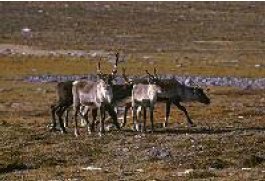 It is not entirely known when the Sami began the
herding and use of reindeer. There are, however,
Chinese sources from as early as 500 A.D. describing a
people in the northeast who used reindeer for
transportation. Other sources tell us that the Sami people
were hunting reindeer as early as the 9th century A.D.
During the 16th and 17th centuries, the Sami began the transition to domesticating reindeer and
practicing nomadism (moving between grazing pastures from season to season). During this period,
the siida system began to fall apart as wild reindeer numbers decreased and new national policies
were instituted, so a new system developed in its place. The Sami increased the number of reindeer
in their herds and reindeer herding became their main area of trade. Reindeer herding in Sweden is
now divided into 51 Sami communities, from Karesuando in the north to Idre in the south. Each
Sami community has an east-west geographical grazing area (50 to 200 kilometers in length) divided into summer, spring, autumn, and winter grazing lands. Agreement on population totals for
the Sami in Sweden vary, but it is estimated that there are between 15,000 and 20,000 Sami living
in Sweden, 900 active reindeer herders, and approximately 3,000 people who can exercise special
Sami resource rights (Beach 1986: 65). It is estimated that there are approximately 300,000
reindeer in the Swedish territories.
It is not entirely known when the Sami began the
herding and use of reindeer. There are, however,
Chinese sources from as early as 500 A.D. describing a
people in the northeast who used reindeer for
transportation. Other sources tell us that the Sami people
were hunting reindeer as early as the 9th century A.D.
During the 16th and 17th centuries, the Sami began the transition to domesticating reindeer and
practicing nomadism (moving between grazing pastures from season to season). During this period,
the siida system began to fall apart as wild reindeer numbers decreased and new national policies
were instituted, so a new system developed in its place. The Sami increased the number of reindeer
in their herds and reindeer herding became their main area of trade. Reindeer herding in Sweden is
now divided into 51 Sami communities, from Karesuando in the north to Idre in the south. Each
Sami community has an east-west geographical grazing area (50 to 200 kilometers in length) divided into summer, spring, autumn, and winter grazing lands. Agreement on population totals for
the Sami in Sweden vary, but it is estimated that there are between 15,000 and 20,000 Sami living
in Sweden, 900 active reindeer herders, and approximately 3,000 people who can exercise special
Sami resource rights (Beach 1986: 65). It is estimated that there are approximately 300,000
reindeer in the Swedish territories.
In the various Sami territories, the Sami may hold different economic positions, and some of these groups have very little involvement in herding at all. Many of the Sami herding lands today are shrinking due to the encroachment of new industry in the samebys, such as the timber and mining industries. Samebys are reindeer collectives that were essentially formed as a result of the Swedish Tax Law of 1605 and the government’s attempt to establish fixed areas for the Sami. These districts were loosely based on existing herding areas, but did not necessarily conform to the Sami’s territory.
The encroachment upon Sami land was inevitable due to the expansion of Sweden, Denmark-Norway, and Russia. As a result of this expansion, various kingdoms began vying for Sami territory. This resulted in many conflicts among these nations, and the Sami would ultimately fall victim to this constant push and pull. The kingdoms fighting for Sami land were, in a sense, attempting to put a cap on foreign expansion. In 1595, The Treaty of Teusina established the border between Russia and Sweden-Finland, and in 1751 the Treaty of Strömstad defined the Norwegian- Swedish border. Included in the treaty was the Lapp Codicil that forced the pastoral Sami to choose between Swedish and Danish-Norwegian citizenship and established the states’ right to regulate trans-border reindeer husbandry (Forrest 1997: 4). Since the establishment of the Lapp Codicil many other treaties and conventions between Norway and Sweden, such as the Karlstad Convention of 1905 (which dissolved the union between Norway and Sweden), have gradually limited trans-border reindeer husbandry.
In earlier times the Scandinavian countries looked upon the Sami as nomads, and by making this determination, were able to deny them rights to their lands. Furthermore, reindeer herding was not seen as a viable economic venture. This view by the Scandinavian states prompted the beginnings of regulation of reindeer herding. The Sami lands in the North were seen as new settlements for farmers, and would be in later times considered new outposts for more modern industry, such as mining and timber.
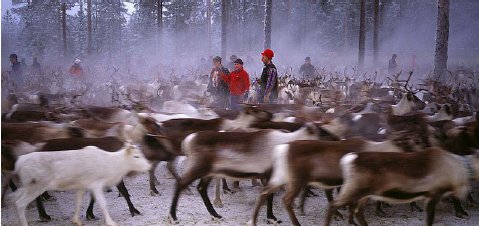
The fact that the Sami have never had a sovereign state and today inhabit an area that has been divided by four countries—Finland, Sweden, Norway, and Russia—has put great pressure on the culture. Various problems persist; one of the greatest has been that of assimilation. The Scandinavian countries sought to steer the pastoral nomadic Sami into more modern economic pursuits or to assimilate them into modern society. This was accomplished by the Swedish government's narrow interpretation of Sami ethnicity, basing it exclusively on economic activity (Forrest 1997: 5). Thus a Sami could only expect cultural protection if he was involved in reindeer herding; all other Sami were legally and culturally assimilated. While it seemed as though traditional Sami herding was under the protection of the government, the time-honored methods of herding were starting to change, further eroding the traditional Sami way of life.
Land rights and the use of these lands for Sami reindeer herding in Sweden have been hotly debated topics for generations of Sami. In 1867 the Swedish government drew a boundary known as the odlingsgräns, to divide the Sami reindeer herds from the settlers. The ultimate goal of this boundary was to protect the forest and the reindeer herds, forbidding any settlement north of the line into Sami herding areas. The odlingsgräns, while seemingly creating a quasi-barrier between the Sami and settlers, actually caused the Sami territories to be divided. Many of the areas once used for herding were now in fact located south of the boundary in the settlement territories. The odlingsgräns would remain, but with the inevitable influx of settlers and the movement north of the railroads in Sweden, the line became little more than a symbol of failed policy.
The first reindeer herding law in Sweden, passed in 1886, is aptly known as the Reindeer Herding Act. It was designed to regulate conflicts between the herders and farmers who had been sent north as homesteading agriculturalists. Farmers complained that Sami reindeer were ruining their fields by overgrazing. The Sami complained that the farmers were catching too many fish, one of the few Sami food sources, and burning forests to clear the land, which drastically reduced the reindeer diet of tree lichens. By passing this law, the Swedish government aimed to promote more intensive herding among the Sami and to establish liability for damages. This law also divided the Sami into villages. This was an attempt to make the Sami, a traditionally nomadic people, more stationary and thus more inclusive in Swedish culture (Korsmo, #11: 4). Farmers approved of this attempt at inclusion as they felt that greater concentrations of Sami in villages would result in more intensive herding, thus minimizing the damage to their fields.
In the 1920's, a policy shift aimed at the Sami's herding practices occurred when the Norwegian government began pressuring the Swedish government to institute a policy by which the Swedish Sami could no longer graze their herds over the border into Norway. The institution of this policy caused the overgrazing of Swedish pastures, and the eventual slaughter of many reindeer by order of Swedish officials. At the same time, the Swedish government began colonization of the North, further reducing the significance of reindeer herding. Because of this colonization and the introduction of mining and timber in the north, the reindeer herds began to shrink (Korsmo 1993: 4- 5). As grazing areas in the north began to diminish the Sami were forced to move their herds, and many families began the trek south in hopes of better grazing lands.
The Swedes began seeing the reindeer herds and the Sami as impediments to the industrial growth of the timber and mining industries. Due to the decreasing role of reindeer herding in the economy and the shrinking of pastures, the Swedish government set out to limit reindeer herding through the reduction of herds and herder populations. The 1928 reindeer herding law limited membership in any village to herders and their families. Sami only possessed the right to herd if one of their parents or grandparents were active in herding as their main occupation.
The Reindeer Herding Act of 1971 attempted to establish the land use rights of the Sami. Although this law appeared to be a major step in creating a stronger cultural identity for the Sami, it was not without its problems. While the law did provide the Sami the right to use the land and water for themselves and their herd, it at the same time limited this right to Sami who had a direct ancestor, such as a father or grandfather who had been a herder. This law also organized the Sami into villages, or samebys, and declared that any herder spending fifty percent or more of their labor on economic pursuits other than herding were no longer eligible for sameby membership. Finally, the law stated that hunting and fishing rights belonged exclusively to those Sami who were members of the sameby. As discussed previously, the membership of Sami into samebys actually comes from the 1928 law. What is new about the 1971 Act is the implementation of a herding fee and a voting system that favored the larger herders. This eventually drove out the smaller herders and caused them, and subsequently their children, to lose the land and water rights associated with sameby membership.
The Swedish government is not the only entity attempting to curtail the Sami right to herd reindeer. Private land owners, specifically individuals with large tracts of forest, are taking the Sami to court over the use of their lands for herding purposes. They claim that the reindeer harm their forests by rubbing against the younger trees with their antlers. The herders do not dispute these allegations, although they claim the damage is not as widespread as the owners of these lands would have the government believe. The private forest owners are seeking compensation for damage to their lands while at the same time attempting to prohibit the Sami from using the land for grazing. This could not only cost the Sami their grazing rights in these areas, but could also cost them a great deal of money, both in compensation and in reimbursement of court costs to the private forest owner.
In the present day, the Sami continue to struggle with the right to use their land for herding. There have been many court cases involving this issue, but little has come of them. For example, in 1990 a trial in Sveg, Sweden questioned the Sami's right to use parts of the forest for grazing in the winter. The trial not only centered around the Sami's indigenous rights, but also questioned land rights for four Sami communities. In 1996 the court ruled that the Sami had no right to use these privately owned lands for winter grazing. The court fees for this trial cost the Sami community nearly .5 million American dollars, bringing them to the brink of bankruptcy. To add insult to injury, the landowners are now petitioning for authorities to collect legal fees from the four communities involved. Cases such as this are ongoing, not only in Sweden, but also in Sami communities in Norway and Finland (Trujillo, 1996: 1-2). As of 1999, there were no less than twelve court cases involving the dispute of winter grazing rights, and as Sami rights are not well defined under Swedish law, the chances are great that the Sami will lose these cases. There are some forest owners who allow herding on their lands because they belong to the FSC, which recognizes grazing rights. The problem of grazing stems from the hundreds of non-certified forest owners who can deny herding rights to Sami without repercussions. The Sami have attempted to set up a compensation fund for these owners, but they have thus far been refused (EU Forest Watch, 1999: #32).
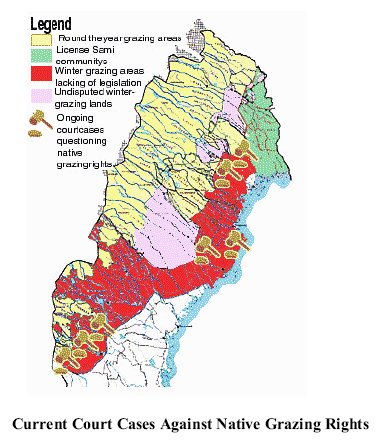
There are different styles of herding used by the Sami; however, the broadest definable styles are intensive herding and extensive herding. The intensive form of herding requires a closer watch of the herd, migrating with them to and from the mountains. This method ensures that fewer reindeer are lost or killed by predators. Until recently, intensive herding was the primary form used by the old nomadic peoples, and it is still practiced within those groups of Sami who are almost entirely dependent on reindeer herding for their livelihoods. By contrast, in the extensive form of herding Sami spend less time travelling with the herd and allow the reindeer to roam more freely. This form of herding is becoming increasingly popular as modern innovations such as the snowmobile, electronic communications, and helicopters have been introduced which allow the Sami to keep track of their herds over larger distances. These herders generally spend less time with the herd. This method, while gaining popularity, is often criticized because of the lack of emphasis placed on the relationship with the reindeer. Herding is deeply woven into the culture of Sami, and many believe that the tendency to embrace this more extensive form of herding is further depleting the rich cultural cache of the Sami people.
It is important to note that, with regard to reindeer husbandry, traditional Sami herders don't simply follow the reindeer, but are engaged in a mutual relationship with the animals. Migration patterns of herds are based on the animals' own natural cycles. The reindeer are deer that live in flocks in the far northern regions of North America, Europe, and Asia. They are ruminant (cudchewing) and both sexes carry antlers. A full-grown reindeer bull can reach a weight of 100-150 kilos just before the rutting period. They are well adapted to the cold, but are not able to tolerate heat. They can conserve water and energy in cold conditions. In the reindeer nose cavity are mucous membrane discs, which warm and moisturize air before it reaches the trachea. Reindeer are well suited to herding in the harsh conditions of northern Sweden, provided the Sami are able to find sufficient grazing land. The reindeer are herded into different areas as the seasons change to improve their chances of finding adequate nutrition.
Sami herding is divided into eight seasons, according to the natural activities of reindeer. The springwinter lasts from March to April. During this time, pregnant females cause the herd to leave the forests and journey to the low mountains and the location of their calving lands. When precisely they make this move depends on the weather, snow conditions, and the availability of grazing. The calving lands are typically in areas where the ground will start to show through the snow earlier than in other locations. They will seek out terrain where they will be somewhat protected from the wind during calving. Since the ground is still mostly covered with snow, the reindeer depend on tree pendant lichens for food.
Spring lasts from April to May, and it is during this period that the calves are born. The reindeer cows (known as the vajor) will usually choose the same time and place to have their calves every year. A reindeer cow will typically have one calf per year, and they will reject their calf from previous year at some point in the spring (either before or after calving). The Sami must be very careful during this season to not disturb the calving reindeer, as too much interference could cause the vaja to abandon her new calf. As the snow is slowly melting during this season, the reindeers diet of lichens may be supplemented with leaves, grass, and some herbs.
The month of June is the pre-summer season. There is little activity or movement during this time, except to find more vegetation for the new mothers and their calves. For this purpose, they may move more into the forests and seek out marshes or brooks. This new vegetation offers an opportunity for all of the reindeer to recuperate the weight they have lost during the long winter. While the reindeer spend this season mostly eating and resting, the reindeer herders will take advantage of this downtime to repair the buildings they use while herding or to build new ones.
The summer season lasts from June to July. As the reindeer are very vulnerable to parasite flies, the reindeer will move to higher elevations where it is cooler and there are fewer insects. The Sami will begin collecting their herds in June to prepare for the calf marking. The reindeer herders will work constantly during this time, day and night, as their herds are dispersed over a very large land area. The herders from various samebyss (reindeer collectives) come together to separate their reindeer. The reindeer are herded down from the mountains into a corral where the calves can be sorted. The only way the herders are able to identify the calves is by identifying each calf’s mother, who is already marked. The calves are captured using a long wooden pole with a loop on one end. This loop is placed over the neck of the reindeer, and the animal is pulled down onto its side to be marked. (Contrary to popular belief, casting cords—a type of lasso—are rarely used today in marking reindeer calves.) The calves are then marked to show to which herder they belong, just as cattle in many parts of the world are branded. When marking a calf, the herder uses a knife to carve various markings into its ear, a painless procedure for the calf. Every Sami group has its own unique marking to distinguish its animals.
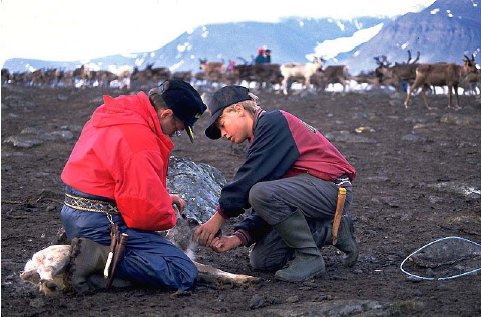
August is the season of pre-autumn. During this period, the reindeer continue building up their fat and muscle to prepare for the rough winter ahead. They will eat a lot of vegetation, including leaves, herbs, grass, and fungi. It is important for the Sami to allow the reindeer this period of restoration, or else their herds will probably not survive the harsh winter. In late August the reindeer are collected again. It is at this time that some of the fattened sarvss (non-castrated males) are slaughtered before they begin rutting in late September,
Autumn comprises the months of September and October. The reindeer stay in the lower mountain regions during this time, as it is beginning to get colder. Vegetation is getting scarcer, and the reindeer will eat mostly roots that they dig up as well as ground lichens. The herders leave the reindeer alone and fish while the sarvss mate with the females in estrus (http://www.sametinget.se). This rutting period lasts about two to three weeks, and the reindeer bulls will use up most of their stored body fat and a lot of their muscle weight in the process.
In pre-winter (November and December) the frost and snow become permanent fixtures of the landscape. It will become more difficult for the reindeer to find grazing land, and once the snow cover reaches 30 centimeters, they will have to resort to grazing on lichens again. During early winter, the reindeer will be separated again, and another round of slaughter will take place. The post-slaughter herd is about seventy-five per cent female. The reindeer are divided into their winter grazing groups (sijdor) and moved to their winter grazing lands in the forest where vegetation is more plentiful.
In winter (December through March), the sijdor groups graze for lichens and berry plants in the coniferous forest belt. The herders will have to move their herds fairly frequently to find grazing lands with adequate food, mostly tree pendant lichens. In some cases, if not enough food can be found, the reindeer's diet may have to be supplemented by the herders to prevent starvation. The grazing lands have been split up by the encroachment of other communities, by roads, railroads, clear cutting, etc. Despite the struggle to find enough food, the reindeer are otherwise very well adapted to the harsh winter, being covered with a dense layer of wool and air-filled cover hairs. The main job of the reindeer herder during this long season is protecting the reindeer on the periphery of the herd from predators (Labba, 1999: 1-4).
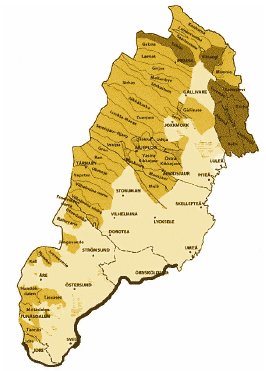
Map showing the Reindeer Grazing Areas in Sweden
Light yellow is the winter grazing area. Dark yellow is the summer grazing period.
One of the many aspects of herding that is evolving is the slaughter of reindeer. The Sami have typically slaughtered reindeer using a special knife that severs the spine. After this, a quick stab to the heart finishes the job. This is considered to be virtually pain free, but has come under fire in recent years from animal rights activists, who claim the traditional Sami method is cruel to the reindeer. A method that is being adopted by many villages is the use of a gun, which drives a spike into the brain of the reindeer, killing it instantly. Many claim that this method causes the least amount of pain, while others argue that the traditional method is less painful. Other customs involved in slaughter methods have also been changed by technological advances. While traditionally, Sami herders would haul and process their own animals, now on the day of the slaughter, a truck will come to carry the reindeer carcasses to a processing plant. In some villages, the Sami no longer skin their own reindeer, but instead have it done by a machine inside this truck. This is yet another way that the Sami are losing some of their traditional methods as the Western world encroaches and forces them to conform to compete and survive.
It is also important to discuss the use of the reindeer after it is slaughtered. In the past the Sami used the entire reindeer for various purposes. The meat provided for the diet, and the marrow inside the bone was also used for food. The meat was typically salted or smoked and made into jerky. Jerky is a valuable food source as it provides nutrients for herders and is easily packed for long migratory journeys. The reindeer’s innards provided casings for sausage and the contents of the stomach are used as well. The blood was kept to eat or to give to the dogs. The antlers were used to make sheaths for knives as well as other tools. The reindeer hides were used for the floors of the goattiehs (traditional shelters) as well as clothing. Sinews from the legs and back were used for sewing. There are many Sami today that complain that having the reindeer processed and skinned by outsiders using modern technology is wasteful, does not honor the old customs of their people, and does not show respect for the animal.
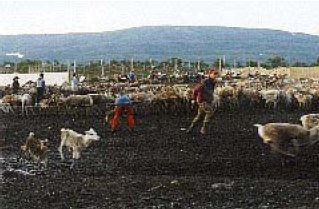 Although many modern influences have
infiltrated the Sami herding practices, the aspect
of shelter has remained relatively unchanged.
When herding the Sami will build goattiehs
along their typical herding route. These structures
are usually small by most standards, but have
been known to hold up to ten Sami at once. They are curvilinear structures, with the frame being
constructed of wood and the façade being built with turf, although the façade can also be
constructed from reindeer hide. The kitchen is housed in the middle of the goattieh, typically
consisting of one kettle for cooking, and the riehpen, the smoke hole directly above the kitchen, is
used for ventilation. One cultural tradition is that one must never step over the kitchen when
crossing from one side of the goattieh to the other, as this is considered a sacred area to the Sami.
One must instead always pass by crossing over the entranceway by the door (Beach 1993: 48-50).
There is no furniture and the floor generally consists of several reindeer hides. These goattiehs are
built and then left for the next season when the herdsman will pass through again. It is also very
common for someone other than the owner to occupy the goattieh should they need shelter when
passing through a particular area. Although shelter for the Sami has remained relatively unchanged,
higher in the mountains the Sami have begun to construct small cabins for winter stays when the
temperature can easily drop to -20˚ F. It is not uncommon to see Sami gathered together in these cabins watching television or cooking over a gas stove, yet more evidence of the invasion of the
modern world into the tradition of reindeer herding.
Although many modern influences have
infiltrated the Sami herding practices, the aspect
of shelter has remained relatively unchanged.
When herding the Sami will build goattiehs
along their typical herding route. These structures
are usually small by most standards, but have
been known to hold up to ten Sami at once. They are curvilinear structures, with the frame being
constructed of wood and the façade being built with turf, although the façade can also be
constructed from reindeer hide. The kitchen is housed in the middle of the goattieh, typically
consisting of one kettle for cooking, and the riehpen, the smoke hole directly above the kitchen, is
used for ventilation. One cultural tradition is that one must never step over the kitchen when
crossing from one side of the goattieh to the other, as this is considered a sacred area to the Sami.
One must instead always pass by crossing over the entranceway by the door (Beach 1993: 48-50).
There is no furniture and the floor generally consists of several reindeer hides. These goattiehs are
built and then left for the next season when the herdsman will pass through again. It is also very
common for someone other than the owner to occupy the goattieh should they need shelter when
passing through a particular area. Although shelter for the Sami has remained relatively unchanged,
higher in the mountains the Sami have begun to construct small cabins for winter stays when the
temperature can easily drop to -20˚ F. It is not uncommon to see Sami gathered together in these cabins watching television or cooking over a gas stove, yet more evidence of the invasion of the
modern world into the tradition of reindeer herding.
One of the biggest problems the herders face is the reindeer’s natural predators. These include the lynx, the wolverine, and the bear, but by far the most disruptive and dangerous predator is the wolf. Wolves pose several problems to the Sami herder. Their presence means the necessity to spend more time watching after the herd, and if the reindeer happen to smell a wolf, it is not uncommon for the herd to scatter, further delaying the migration. The wolf is an efficient and clever hunter. It will typically attack a reindeer by biting one of its hind legs and will hold steady until the animal falls. The wolf will then bite the reindeer under the neck until it dies. Wolves have been known to disguise their sounds by placing their nose under the snow to trick the herd into thinking they are further away. The reindeer are able to defend themselves by running from the wolves and distancing themselves. Reindeer average about 25 mph when trotting but can run twice as fast when escaping predators. Calving can be a particularly dangerous time for the reindeer, as the calves are especially vulnerable when they are first born. Some calving grounds are located on islands off the coast, forcing the reindeer to swim to these areas. This is believed to have developed as a defense against predators on the mainland. Today, the wolves in Sweden are a protected species, making hunting them illegal. There is no real consensus on the actual number of wolves in Sweden today, and it is believed that many of the attacks that occur are the result of wolves crossing over into the area from Russia via Finland (Beach 1993: 174-176). Although the herders are allowed to kill wolves attacking their reindeer, the laws now governing the kill are quite strict, and make it virtually impossible for herders to control the problem.
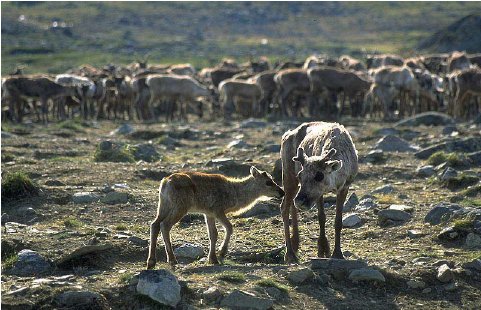
The reindeer is deeply embedded in Sami culture. From the storytelling traditions known as yoiking, to famous stone engravings of reindeer found in Alta, Norway, the reindeer has played an integral role in the lives of the Sami people since before the birth of Christ. Centuries of persecution of the people themselves, as well as attempts to severely hamper the herding practices of the Sami, have put their cultural heritage at risk. More recently, various outside influences and the modernization of herding into an industry have threatened the herding tradition. Many have sought to turn this icon of Sami culture into nothing more than a tourist trade. With the transformation of herding practices to more extensive herding, in part due to modern technology, the Sami put themselves further at risk of being a cutural casualty. We have seen the coming of modern industry and the ravages it has wrought on the forest, as well as the private owners bringing the Sami to financial ruin with continuous lawsuits. Perhaps if more people in Sweden and throughout Scandinavia were more knowledgeable about the lifestyle and traditional herding practices of the Sami, they would not only be more willing, but perhaps even insist upon, giving the Sami the freedom to reclaim their past and pass it on to future generations.
BIBILOGRAPHY
Beach, Hugh. A Year in Lapland: Guest of the Reindeer Herders. Smithsonian Institution Press, 1993.
Forrest, Scott. “Territoriality and State-Sami Relations.” University of Northern British Columbia, 1997.
Johansson, Oloft. “Reindeer Herding and Forestry in Northern Sweden.” http://www.oloft.com/casestudy.html
Korsmo, Fae. “Swedish Policy and Saami Rights.” The Northern Review #11. 32-55, 1993.
Labba, Nils Gustav. “Reindeer Herding in General.” February, 1999. http://www.oloft.com/herding.htm
Trujillo, Gary S. “Sami Grazing Rights Threatened in Sweden.” March, 1996. http://nativenet.uthscsa.edu/archive/nl/9605/0072.html
Yli-Kuha, Kari. “The Sami.” http://www.lysator.liu.se/nordic/scn/faq23.html
EU Forest Watch: March 1999, Issue #32: http://www.fern.org/Library/FW/FW99/March%2099.htm
Sami Parliament Web Site. http://www.sametinget.se
Boreale Web Site. “Description of the Reindeer of Scandinavia and Northern Russia.” http://www.itv.se/boreale/bovts.htm
Swedish Institute Web Site. “The Sami People in Sweden” http://www.si.se/infosweden/287.cs
Photos:
http://www.itv.se/boreale/bovts.htm
http://www.oloft.com/casestudy.html
http://www.fjallen.nu/sapmi/index_en.htm
